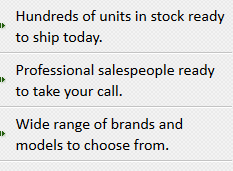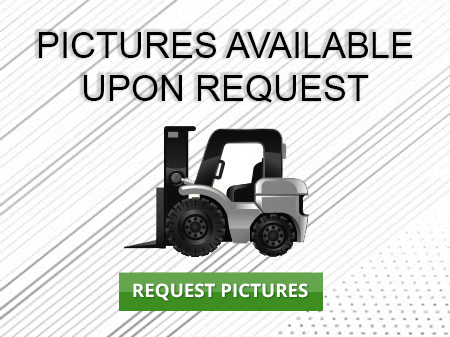Rough Terrain Forklift Bellevue
Used Rough Terrain Forklift Bellevue - Forklifts rely on two forks to unload, load and transport items. Forklifts fall into two main categories, industrial forklifts and rough terrain forklifts.
The first category of forklifts, industrial forklifts, are mostly used in warehouses and at loading docks on surfaces that are relatively smooth and level. Ideal for uneven terrain and rocky locations, rough terrain forklifts travel well in difficult environments. Rough terrain forklifts are often seen at construction sites and outdoors. They have the weight capacity, size and tires to handle heavy loads. The main difference between industrial and rough terrain forklifts is that industrial forklifts are fitted with cushion tires, a common, over-the-road type tire. Rough terrain forklifts, on the other hand, are fitted with pneumatic tires, a type of tractor tire allowing for better traction and flotation properties. Internal combustion engines can power industrial forklifts; however, more often they rely on an electrical source such as a fuel cell or better. Rough terrain models typically rely on an internal combustion engine.
Types of Class 7 Rough Terrain Forklift Trucks
There are three main kinds of Class 7 Rough Terrain Forklift Trucks. The rotating telehandler forklift, straight mast forklifts and rotating forklifts are in this category.
Every rough terrain forklift truck is designed to operate on disturbed ground and difficult locations commonly found in military and construction atmospheres. Rough terrain forklift units have better performance and maneuvering options. In the case of rough terrain forklift operations, extra consideration must be given while raising loads in these rough, variable conditions to prevent tip-over. As with all forklift operation, the machine must be in a position to remain stable before lifting, transporting or lowering a load. Rough terrain forklift operators must practice correct lifting techniques to remain stable on the ground.
Straight Mast Forklifts
Straight mast forklifts are designed to transport building materials around a range of rough terrain sites such as demolition and construction sites. Pneumatic cushion tires allow this forklift better maneuverability and accessibility around difficult terrain. Uneven ground and rough surfaces are no match for pneumatic tires. The majority of straight mast forklifts come in both two wheel and four wheel drive capabilities. Even though these machines are better utilized in exterior locations, many straight mast forklifts operate with propane or diesel, enabling them to be used indoors for short timeframes. The lift capacities of straight mast forklifts are similar to most standard forklifts with a range of approximately 5,000 to 36,000 pounds.
Telehandler or Telescopic Handler Forklifts
Telehandler or telescopic handler forklift trucks are equipped with a telescoping boom, giving them their name. Telescoping booms are handy for allowing the machine to load and place items at different lift heights and distances in front of the forklift. The reachability of the forklift provides the operator with greater flexibility when placing a load.
Featuring two wheels found at the front and two wheels at the rear, the standard telehandler is a long and low machine. The telescopic boom can be found at the back of the forklift, mounted on a pivot that is attached many feet higher than the frame of the unit. The hydraulic fluid tank and fuel tank are mounted on the opposite side of the cab which is usually situated on the left side of the forklift. Within the frame itself, the transmission and engine are located along the center-line of the forklift. This popular design showcases a balanced forklift which is ideal for the machine’s stability with lifting, moving and lowering items.
Telehandler forklifts provide much greater lift heights when compared to a standard forklift. High-reach telehandlers can extend their full load capacity to 56 feet. The compact telehandlers can extend their full load capacity from 18 feet. Load capacities are between 5K to 12K pounds.
All-terrain forklifts often include all-wheel steering which allows for greater maneuverability. This, along with power shift transmission and other steering features, means that the operator can move the lift in as close proximity to the work area as possible.
Recent telehandler units showcase top-of-the-line ergonomic design to generate increased comfort and operator satisfaction. Operator comfort is enhanced via larger cabs and tilted steering. High in demand at job sites, these ergonomic options reduce operator fatigue and repetitive stress injuries.
A single joystick is a common design for most telehandlers. The joystick is responsible for the hydraulic system and the boom operations.
Telehandler forklifts can also be equipped with non-marking tires which allow them to be used in other applications such as the installation of signs and billboards as well as maintenance on buildings and stadiums.
Rotating Telehandler or Roto Telescopic Handler Forklifts
Rotating telehandler or roto telescopic handler forklifts have many features in common with the standard telehandler forklift. Telehandlers are capable of rotating heavy-lift weights to tremendous heights. However, these forklifts have the added ability to rotate the forklift on a turntable. The rotating function allows the forklift to swivel a full 360 degrees around, enabling access a much larger work area without having to reposition the forklift.
Commonly, rotating telehandlers have another joystick to handle the rotation portion separately from the lift function. As with the standard telehandler forklift, rotating telehandlers are available with added features including power assist steering, four-wheel drive and minimized slip differential on the rear axle to boost traction and for additional safety.
With the added rotating ability of these forklifts, comes additional safety considerations. Stabilizers are a rough terrain forklift feature that rotating telehandler models rely on to increase safety while handling rotating loads that are swinging back and forth from each side of the machine. Certain rotating telehandlers operate without stabilizers; minimizing the time it takes to reposition the machine and move to other workplace locations.
The standard telehandler offers fixed cab components and rotator telehandlers are generally smaller in comparison. Understandably, rotator telehandler machines can handler smaller load capacities compared to their standard telehandler counterparts. Ranging between four thousand and ten thousand pounds, rotating telehandlers can reach lift heights from 15 to 80 feet.
Winch attachments can transform rotator telehandlers and standard models into a crane. This means that these forklifts can sometimes allow a project to forego the need for a crane at the jobsite, saving time, expense and workspace.
Advancements for Rough Terrain Forklifts
Many attachments are currently available for rough terrain forklifts, such as booms, winches, rotating fork carriages and articulating booms. Forklift attachments are vital for diversifying the machine. They will continue to be developed for years to come.
The majority of advancements will be delivered as safety features built to enhance the rough terrain models. The latest safety upgrades include automatic load restriction and other features. By automatically weighing a load, these systems calculate the loads’ safe reach distance while taking the boom angle and its’ extension into account. An alarm will go off once the safe distance is reached. This alerts the operator that immediate adjustments need to be made to the boom angle, reach distance or load weight.
Rough Terrain Forklift PDF
Stock Number: DP-MAN008 GL
Make: MANITOU
Model: MH25-4T
Year: 2016
Price: $58,500
| Stock Number |
DP-MAN008 GL |
| Make |
MANITOU |
| Model |
MH25-4T |
| Year |
2016 |
| Category |
Rough Terrain Forklift |
Stock Number: 209058 GL
Make: LIFTKING
Model: LK12M42
Year: 2015
| Stock Number |
209058 GL |
| Make |
LIFTKING |
| Model |
LK12M42 |
| Year |
2015 |
| Category |
Rough Terrain Forklift |
Stock Number: 267846 GL
Make: Liftking
Model: LK12000
Year: 2003
Price: $60,000
| Stock Number |
267846 GL |
| Make |
Liftking |
| Model |
LK12000 |
| Year |
2003 |
| Category |
Rough Terrain Forklift |
Stock Number: 208325 GL
Make: MANITOU
Model: M50.4
Year: 2015
| Stock Number |
208325 GL |
| Make |
MANITOU |
| Model |
M50.4 |
| Year |
2015 |
| Category |
Rough Terrain Forklift |
Stock Number: LS15257 GL
Make: JCB
Model: 930
Year: 2013
| Stock Number |
LS15257 GL |
| Make |
JCB |
| Model |
930 |
| Year |
2013 |
| Category |
Rough Terrain Forklift |
Stock Number: EQC008213 GL
Make: MANITOU
Model: M50
Year: 2017
| Stock Number |
EQC008213 GL |
| Make |
MANITOU |
| Model |
M50 |
| Year |
2017 |
| Category |
Rough Terrain Forklift |



























